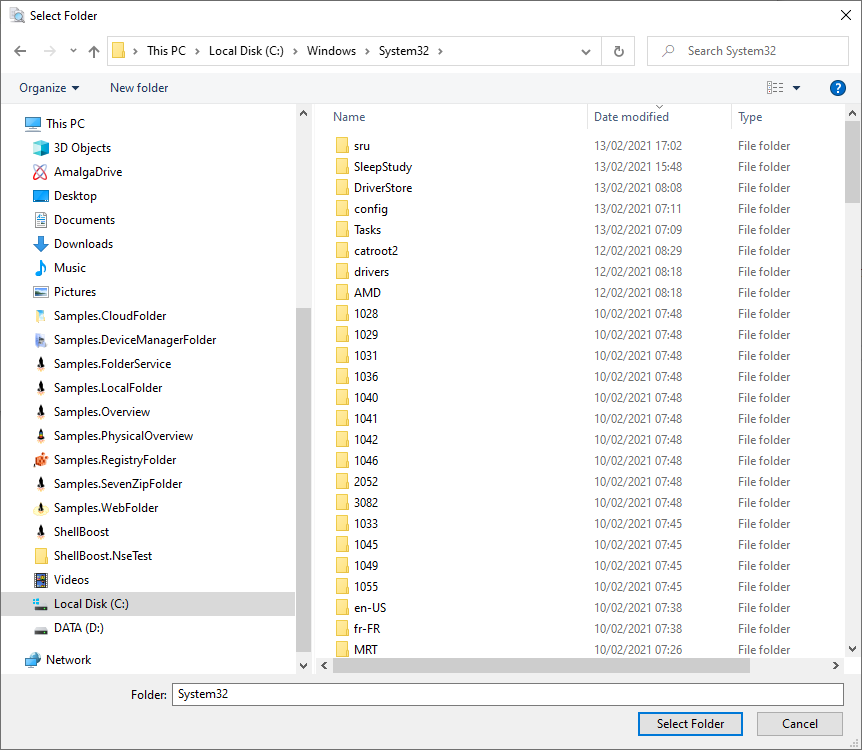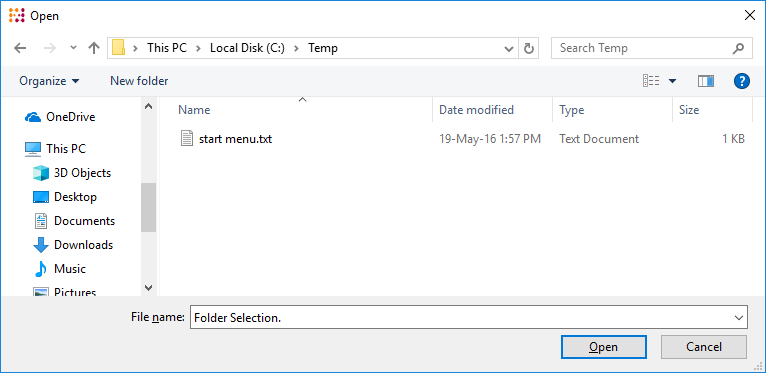Here is a pure C# version, nuget-free, that should work with all versions of .NET (including .NET Core, .NET 5, WPF, Winforms, etc.) and uses Windows Vista (and higher) IFileDialog interface with the FOS_PICKFOLDERS options so it has the nice folder picker Windows standard UI.
Update 2023/3/17: the class now support multiple selection.
I have also added WPF's Window type support but this is optional, the WPF-marked lines can just be removed.
usage:
var dlg = new FolderPicker();
dlg.InputPath = @"c:\windows\system32";
if (dlg.ShowDialog() == true)
{
MessageBox.Show(dlg.ResultPath);
}
code:
using System;
using System.Collections.Generic;
using System.Diagnostics;
using System.Linq;
using System.Runtime.InteropServices;
using System.Runtime.InteropServices.ComTypes;
using System.Windows;
using System.Windows.Interop;
public class FolderPicker
{
private readonly List<string> _resultPaths = new List<string>();
private readonly List<string> _resultNames = new List<string>();
public IReadOnlyList<string> ResultPaths => _resultPaths;
public IReadOnlyList<string> ResultNames => _resultNames;
public string ResultPath => ResultPaths.FirstOrDefault();
public string ResultName => ResultNames.FirstOrDefault();
public virtual string InputPath { get; set; }
public virtual bool ForceFileSystem { get; set; }
public virtual bool Multiselect { get; set; }
public virtual string Title { get; set; }
public virtual string OkButtonLabel { get; set; }
public virtual string FileNameLabel { get; set; }
protected virtual int SetOptions(int options)
{
if (ForceFileSystem)
{
options |= (int)FOS.FOS_FORCEFILESYSTEM;
}
if (Multiselect)
{
options |= (int)FOS.FOS_ALLOWMULTISELECT;
}
return options;
}
// for WPF support
public bool? ShowDialog(Window owner = null, bool throwOnError = false)
{
owner = owner ?? Application.Current?.MainWindow;
return ShowDialog(owner != null ? new WindowInteropHelper(owner).Handle : IntPtr.Zero, throwOnError);
}
// for all .NET
public virtual bool? ShowDialog(IntPtr owner, bool throwOnError = false)
{
var dialog = (IFileOpenDialog)new FileOpenDialog();
if (!string.IsNullOrEmpty(InputPath))
{
if (CheckHr(SHCreateItemFromParsingName(InputPath, null, typeof(IShellItem).GUID, out var item), throwOnError) != 0)
return null;
dialog.SetFolder(item);
}
var options = FOS.FOS_PICKFOLDERS;
options = (FOS)SetOptions((int)options);
dialog.SetOptions(options);
if (Title != null)
{
dialog.SetTitle(Title);
}
if (OkButtonLabel != null)
{
dialog.SetOkButtonLabel(OkButtonLabel);
}
if (FileNameLabel != null)
{
dialog.SetFileName(FileNameLabel);
}
if (owner == IntPtr.Zero)
{
owner = Process.GetCurrentProcess().MainWindowHandle;
if (owner == IntPtr.Zero)
{
owner = GetDesktopWindow();
}
}
var hr = dialog.Show(owner);
if (hr == ERROR_CANCELLED)
return null;
if (CheckHr(hr, throwOnError) != 0)
return null;
if (CheckHr(dialog.GetResults(out var items), throwOnError) != 0)
return null;
items.GetCount(out var count);
for (var i = 0; i < count; i++)
{
items.GetItemAt(i, out var item);
CheckHr(item.GetDisplayName(SIGDN.SIGDN_DESKTOPABSOLUTEPARSING, out var path), throwOnError);
CheckHr(item.GetDisplayName(SIGDN.SIGDN_DESKTOPABSOLUTEEDITING, out var name), throwOnError);
if (path != null || name != null)
{
_resultPaths.Add(path);
_resultNames.Add(name);
}
}
return true;
}
private static int CheckHr(int hr, bool throwOnError)
{
if (hr != 0 && throwOnError) Marshal.ThrowExceptionForHR(hr);
return hr;
}
[DllImport("shell32")]
private static extern int SHCreateItemFromParsingName([MarshalAs(UnmanagedType.LPWStr)] string pszPath, IBindCtx pbc, [MarshalAs(UnmanagedType.LPStruct)] Guid riid, out IShellItem ppv);
[DllImport("user32")]
private static extern IntPtr GetDesktopWindow();
#pragma warning disable IDE1006 // Naming Styles
private const int ERROR_CANCELLED = unchecked((int)0x800704C7);
#pragma warning restore IDE1006 // Naming Styles
[ComImport, Guid("DC1C5A9C-E88A-4dde-A5A1-60F82A20AEF7")] // CLSID_FileOpenDialog
private class FileOpenDialog { }
[ComImport, Guid("d57c7288-d4ad-4768-be02-9d969532d960"), InterfaceType(ComInterfaceType.InterfaceIsIUnknown)]
private interface IFileOpenDialog
{
[PreserveSig] int Show(IntPtr parent); // IModalWindow
[PreserveSig] int SetFileTypes(); // not fully defined
[PreserveSig] int SetFileTypeIndex(int iFileType);
[PreserveSig] int GetFileTypeIndex(out int piFileType);
[PreserveSig] int Advise(); // not fully defined
[PreserveSig] int Unadvise();
[PreserveSig] int SetOptions(FOS fos);
[PreserveSig] int GetOptions(out FOS pfos);
[PreserveSig] int SetDefaultFolder(IShellItem psi);
[PreserveSig] int SetFolder(IShellItem psi);
[PreserveSig] int GetFolder(out IShellItem ppsi);
[PreserveSig] int GetCurrentSelection(out IShellItem ppsi);
[PreserveSig] int SetFileName([MarshalAs(UnmanagedType.LPWStr)] string pszName);
[PreserveSig] int GetFileName([MarshalAs(UnmanagedType.LPWStr)] out string pszName);
[PreserveSig] int SetTitle([MarshalAs(UnmanagedType.LPWStr)] string pszTitle);
[PreserveSig] int SetOkButtonLabel([MarshalAs(UnmanagedType.LPWStr)] string pszText);
[PreserveSig] int SetFileNameLabel([MarshalAs(UnmanagedType.LPWStr)] string pszLabel);
[PreserveSig] int GetResult(out IShellItem ppsi);
[PreserveSig] int AddPlace(IShellItem psi, int alignment);
[PreserveSig] int SetDefaultExtension([MarshalAs(UnmanagedType.LPWStr)] string pszDefaultExtension);
[PreserveSig] int Close(int hr);
[PreserveSig] int SetClientGuid(); // not fully defined
[PreserveSig] int ClearClientData();
[PreserveSig] int SetFilter([MarshalAs(UnmanagedType.IUnknown)] object pFilter);
[PreserveSig] int GetResults(out IShellItemArray ppenum);
[PreserveSig] int GetSelectedItems([MarshalAs(UnmanagedType.IUnknown)] out object ppsai);
}
[ComImport, Guid("43826D1E-E718-42EE-BC55-A1E261C37BFE"), InterfaceType(ComInterfaceType.InterfaceIsIUnknown)]
private interface IShellItem
{
[PreserveSig] int BindToHandler(); // not fully defined
[PreserveSig] int GetParent(); // not fully defined
[PreserveSig] int GetDisplayName(SIGDN sigdnName, [MarshalAs(UnmanagedType.LPWStr)] out string ppszName);
[PreserveSig] int GetAttributes(); // not fully defined
[PreserveSig] int Compare(); // not fully defined
}
[ComImport, Guid("b63ea76d-1f85-456f-a19c-48159efa858b"), InterfaceType(ComInterfaceType.InterfaceIsIUnknown)]
private interface IShellItemArray
{
[PreserveSig] int BindToHandler(); // not fully defined
[PreserveSig] int GetPropertyStore(); // not fully defined
[PreserveSig] int GetPropertyDescriptionList(); // not fully defined
[PreserveSig] int GetAttributes(); // not fully defined
[PreserveSig] int GetCount(out int pdwNumItems);
[PreserveSig] int GetItemAt(int dwIndex, out IShellItem ppsi);
[PreserveSig] int EnumItems(); // not fully defined
}
#pragma warning disable CA1712 // Do not prefix enum values with type name
private enum SIGDN : uint
{
SIGDN_DESKTOPABSOLUTEEDITING = 0x8004c000,
SIGDN_DESKTOPABSOLUTEPARSING = 0x80028000,
SIGDN_FILESYSPATH = 0x80058000,
SIGDN_NORMALDISPLAY = 0,
SIGDN_PARENTRELATIVE = 0x80080001,
SIGDN_PARENTRELATIVEEDITING = 0x80031001,
SIGDN_PARENTRELATIVEFORADDRESSBAR = 0x8007c001,
SIGDN_PARENTRELATIVEPARSING = 0x80018001,
SIGDN_URL = 0x80068000
}
[Flags]
private enum FOS
{
FOS_OVERWRITEPROMPT = 0x2,
FOS_STRICTFILETYPES = 0x4,
FOS_NOCHANGEDIR = 0x8,
FOS_PICKFOLDERS = 0x20,
FOS_FORCEFILESYSTEM = 0x40,
FOS_ALLNONSTORAGEITEMS = 0x80,
FOS_NOVALIDATE = 0x100,
FOS_ALLOWMULTISELECT = 0x200,
FOS_PATHMUSTEXIST = 0x800,
FOS_FILEMUSTEXIST = 0x1000,
FOS_CREATEPROMPT = 0x2000,
FOS_SHAREAWARE = 0x4000,
FOS_NOREADONLYRETURN = 0x8000,
FOS_NOTESTFILECREATE = 0x10000,
FOS_HIDEMRUPLACES = 0x20000,
FOS_HIDEPINNEDPLACES = 0x40000,
FOS_NODEREFERENCELINKS = 0x100000,
FOS_OKBUTTONNEEDSINTERACTION = 0x200000,
FOS_DONTADDTORECENT = 0x2000000,
FOS_FORCESHOWHIDDEN = 0x10000000,
FOS_DEFAULTNOMINIMODE = 0x20000000,
FOS_FORCEPREVIEWPANEON = 0x40000000,
FOS_SUPPORTSTREAMABLEITEMS = unchecked((int)0x80000000)
}
#pragma warning restore CA1712 // Do not prefix enum values with type name
}
result:
![enter image description here]()




ValidateNamesandCheckFileExistsare both set to false andFileNameis given a mock value to indicate that a directory is selected. I say hack because it is confusing to users about how to select a folder. See Select file or folder from the same dialog – CantoValidateNamesandCheckFileExiststofalsewas not working, I needed to set them to0(or learn powershell better) – Lurlenelurline